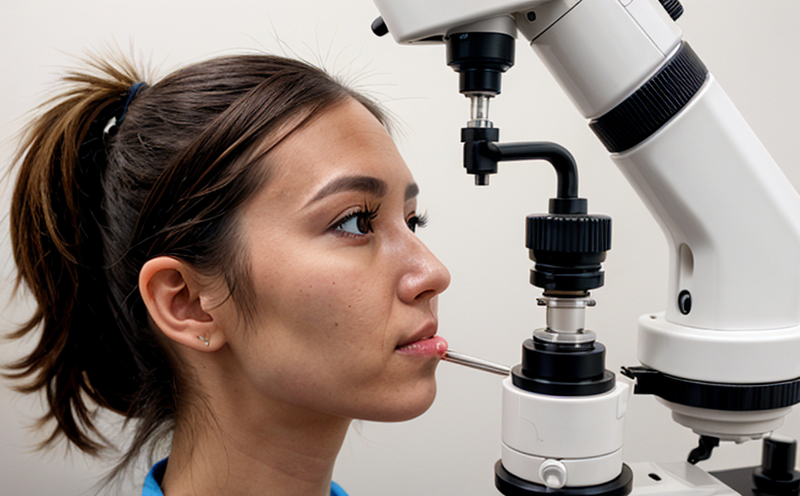ASTM F1929 Dye Penetration Integrity Testing of Lens Packaging
The ASTM F1929 dye penetration integrity testing is a critical procedure used in medical device quality assurance. This test evaluates the effectiveness of lens packaging materials in preventing microbial contamination by simulating real-world conditions through the use of a dye solution.
This method is especially important for lenses that are meant to be worn directly on the eye, as even minimal breaches can lead to serious infections and health risks. The testing ensures that the integrity of the packaging remains intact throughout storage and distribution, thereby protecting the sterility of the lenses.
The test typically involves submerging a sample of lens packaging in a solution containing a dye (such as India ink) under controlled conditions. After a specified period, the package is inspected for any signs of dye penetration. If no penetration occurs, it indicates that the packaging has maintained its integrity and can be considered effective.
The process requires precise control over environmental factors such as temperature, humidity, and time to ensure accurate results. The testing apparatus used includes specialized chambers designed to simulate various storage conditions. This ensures that the test accurately reflects real-world scenarios where lenses are stored before use.
Testing according to ASTM F1929 is mandatory for compliance with regulatory requirements set by organizations such as the United States Food and Drug Administration (FDA). Compliance with these standards helps manufacturers ensure their products meet safety and efficacy criteria, which in turn enhances consumer trust and product quality.
The results of this test are crucial not only from a regulatory standpoint but also from an operational one. They help identify potential weaknesses early on, allowing for corrective measures to be taken promptly. This proactive approach is vital for maintaining high standards of quality control within the medical device industry.
Quality and Reliability Assurance
- Consistency: Ensures that every batch produced meets the same stringent standards.
- Reduction in Failures: Helps minimize defects and rejections during production runs.
- Patient Safety: Guarantees that medical devices remain sterile and safe for use, thereby protecting public health.
The process of dye penetration integrity testing ensures a high level of quality assurance by providing reliable data on the effectiveness of lens packaging. This not only aids in maintaining consistent product quality but also helps reduce operational inefficiencies associated with rework or scrap. By adhering to rigorous testing protocols, manufacturers can enhance their reputation for reliability and safety.
Moreover, this form of testing plays a significant role in ensuring that medical devices comply with relevant international standards like ISO 11135-2, which specifies the requirements for sterilization of medical devices by ethylene oxide. This compliance is essential not only within the U.S., but also globally where many countries adopt these standards as part of their regulatory frameworks.
Understanding how to properly conduct and interpret the results of ASTM F1929 dye penetration integrity tests helps ensure that quality assurance measures are effective in protecting both patients and manufacturers from potential risks associated with non-compliant products.
International Acceptance and Recognition
The ASTM F1929 dye penetration integrity test has gained widespread acceptance across various international markets due to its rigorous methodology and consistent results. Regulatory bodies worldwide recognize the importance of this testing in ensuring medical device safety, particularly for contact lenses.
In countries such as Australia, Canada, and Europe, compliance with ASTM standards is often a prerequisite for market entry. This means that manufacturers must demonstrate adherence to these guidelines before their products can be sold legally within those regions. For instance, the European Union (EU) requires conformity to relevant ISO/IEC standards including those related to medical device sterility testing.
The acceptance of ASTM F1929 extends beyond just regulatory compliance; it also fosters trust among healthcare professionals and patients alike by establishing a benchmark for quality assurance. This standardization ensures that regardless of where the product is manufactured or sold, consumers can expect consistent levels of safety and efficacy.
Manufacturers who adhere to these standards benefit from enhanced credibility in the marketplace as they signal their commitment to maintaining high standards of production practices. Such adherence also facilitates smoother interactions between different healthcare systems internationally since there's a shared understanding regarding acceptable testing procedures.
Use Cases and Application Examples
| Use Case | Description |
|---|---|
| Contact Lens Packaging Testing | This involves evaluating the integrity of packaging materials used for storing contact lenses before they reach end-users. |
| Surgical Lens Integrity Assessment | Ensuring that surgical lenses remain sterile and intact during storage and transportation to the operating theater. |
| Routine Quality Control Checks | Regular testing of lens packaging to ensure ongoing compliance with international standards and regulations. |
| Developmental Testing for New Products | Evaluating new materials or designs for contact lenses during the R&D phase before finalizing product specifications. |
| Post-Market Surveillance | Monitoring the performance of already approved products to detect any potential issues that may arise after they have been released into the market. |
The ASTM F1929 dye penetration integrity test finds application in diverse scenarios ranging from routine quality control checks to developmental testing for new products. It serves as a cornerstone in safeguarding patient safety by ensuring that lenses remain sterile and intact throughout their lifecycle, from manufacturing until final use.





